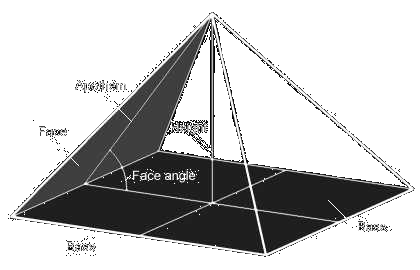| As structures | Exploration | History | As tombs | Overview -|- History of Ancient Egypt | My Homepage |
|
The pyramids are the most magnificent structures ever built by a human. The biggest of them, the Great pyramid (also known as Khufu's or Keops/Cheops pyramid), is nearly 150 m high. It has a volume of over 2.5 million cubic meters and was built with incredible precision. The time needed to lay more than 2 million blocks was about 23 years. Also, it is the first of the 'Seven Wonders of the World' and the only one still standing. |
|
|
The pyramids have a quadratic base. The angle of the faces varies between the pyramids but is around 52 degrees. Two mathematical relations that can be derived from these geometric characteristics are often quoted. The first, the perimeter of the circle, which has a radius equal to the pyramid's height, is equal to the perimeter of the pyramid's base. The second, the ratio of apothem to its projection on the horizontal plane (i.e. half of the side of the base) is equal to the value of 'Golden Section'. Or, which is the same, the area of the square with the side equal to pyramid's height is equal to the area of a pyramid's face. If you are keen on maths (and new theories), you may want to read this article on Great pyramid's geometry. |
 |
|
Slight deviations from the pyramidal form are known in two cases. The Step pyramid is of step-like shape and its base is rectangular but not square. The Bent pyramid's sides are bent at a certain height. Originally, the sufrace of the pyramids was covered with casing blocks of resistant marble-like hard limestone. The core was made mostly of softer limestone blocks, but also granite and basalt were used in construction. The heaviest by now discovered block weights around 70 tonnes. Later, mud bricks were used for the construction of the core. |
|
Golden Section: divide a line in two sections so that a ratio of the whole line length to longer section is equal to the ratio of longer to shorter section. This ratio is called the 'Golden Section'.
![]() Proceede to Exploration of the Pyramids.
Proceede to Exploration of the Pyramids.